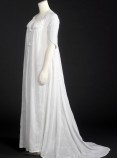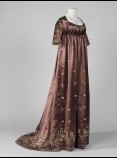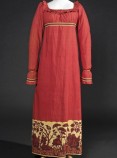1789–1825

Dress. Spain. 1790-1810. Cotton batiste, white embroidery. Donated by the Forn-Homs family, 2002. MTIB 2875/02

Dress. Madrid. 1803-1807. Silk satin, silk embroidery, appliqué of silk satin and net, sequins, metal and glass. Donated by Manuel Rocamora, 1969. MTIB 88031

Dress and Revolution. The body set free
The social transformation set in motion by the French Revolution is reflected in dress. Napoleon suppressed by decree the symbols of the aristocracy: corsets, paniers, breeches and heeled shoes.
Clothes were simplified. For both men and women the silhouette becomes rectilinear, following the model of Greek statues. Women wear chemises dresses. The waistline is raised to just below the chest.


